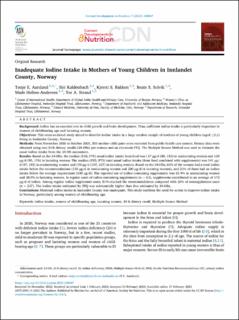| dc.contributor.author | Aarsland, Tonje Eiane | |
| dc.contributor.author | Kaldenbach, Siri | |
| dc.contributor.author | Bakken, Kjersti Sletten | |
| dc.contributor.author | Solvik, Beate Stokke | |
| dc.contributor.author | Holten-Andersen, Mads Nikolaj | |
| dc.contributor.author | Strand, Tor Arne | |
| dc.date.accessioned | 2024-02-01T13:24:03Z | |
| dc.date.available | 2024-02-01T13:24:03Z | |
| dc.date.created | 2023-05-31T22:26:29Z | |
| dc.date.issued | 2023 | |
| dc.identifier.issn | 2475-2991 | |
| dc.identifier.uri | https://hdl.handle.net/11250/3115074 | |
| dc.description.abstract | Background: Iodine has an essential role in child growth and brain development. Thus, sufficient iodine intake is particularly important in women of childbearing age and lactating women. Objectives: This cross-sectional study aimed to describe iodine intake in a large random sample of mothers of young children (aged ≤2 y) living in Innlandet County, Norway. Methods: From November 2020 to October 2021, 355 mother-child pairs were recruited from public health care centers. Dietary data were obtained using two 24-h dietary recalls (24-HRs) per woman and an electronic FFQ. The Multiple Source Method was used to estimate the usual iodine intake from the 24-HR assessment. Results: Based on the 24-HRs, the median (P25, P75) usual iodine intake from food was 117 μg/d (88, 153) in nonlactating women and 129 μg/d (95, 176) in lactating women. The median (P25, P75) total usual iodine intake (from food combined with supplements) was 141 μg/d (97, 185) in nonlactating women and 153 μg/d (107, 227) in lactating women. Based on the 24-HRs, 62% of the women had a total iodine intake below the recommendations (150 μg/d in nonlactating women and 200 μg/d in lactating women), and 23% of them had an iodine intake below the average requirement (100 μg/d). The reported use of iodine-containing supplements was 21.4% in nonlactating women and 28.9% in lactating women. In regular users of iodine-containing supplements (n = 63), supplements contributed to an average of 172 μg/d of iodine. Among regular iodine supplement users, 81% reached the recommendations compared with 26% of nonsupplement users (n = 237). The iodine intake estimated by FFQ was substantially higher than that estimated by 24-HRs. Conclusions: Maternal iodine intake in Innlandet County was inadequate. This study confirms the need for action to improve iodine intake in Norway, particularly among women of childbearing age. Keywords: 24-h dietary recall; Multiple Source Method; iodine intake; lactating women; women of childbearing age. © 2023 The Authors. | en_US |
| dc.language.iso | eng | en_US |
| dc.publisher | Elsevier | en_US |
| dc.rights | Navngivelse 4.0 Internasjonal | * |
| dc.rights.uri | http://creativecommons.org/licenses/by/4.0/deed.no | * |
| dc.title | Inadequate Iodine Intake in Mothers of Young Children in Innlandet County, Norway | en_US |
| dc.type | Journal article | en_US |
| dc.type | Peer reviewed | en_US |
| dc.description.version | publishedVersion | en_US |
| dc.rights.holder | Copyright 2023 The Author(s) | en_US |
| dc.source.articlenumber | 100047 | en_US |
| cristin.ispublished | true | |
| cristin.fulltext | original | |
| cristin.qualitycode | 1 | |
| dc.identifier.doi | 10.1016/j.cdnut.2023.100047 | |
| dc.identifier.cristin | 2150629 | |
| dc.source.journal | Current Developments in Nutrition (CDN) | en_US |
| dc.identifier.citation | Current Developments in Nutrition (CDN). 2023, 7 (3), 100047. | en_US |
| dc.source.volume | 7 | en_US |
| dc.source.issue | 3 | en_US |

